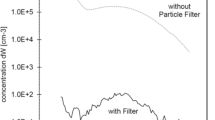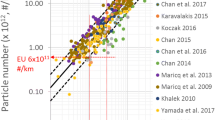Abstract
During the past fifteen years the gaseous components of automotive exhaust have been widely investigated to evaluate their role in air pollution. Relatively little effort has been devoted to the study of particulates emitted from automotive engines. The reason for the greater interest in gaseous emissions is understandable since gaseous components are emitted in considerably larger amounts than particulates, as illustrated in Fig. 1. Nevertheless, gasoline engines still introduce into the United States’ atmosphere about one million tons of particulate matter annually,(1) contributing significantly to air pollution. Most notably, particulates affect (a) solar radiation and climate near the ground, (b) visibility, (c) material damage, (d) vegetation, and (e) health. In this paper, these effects are not examined in detail (interested readers are referred to the comprehensive summaries given in Ref. 2); instead, attention is focused on the emission of particulates from spark-ignition engines.
Access this chapter
Tax calculation will be finalised at checkout
Purchases are for personal use only
Preview
Unable to display preview. Download preview PDF.
Similar content being viewed by others
References
The Sources of Air Pollution and Their Control, PHS-Pub-1548, (revised) 1968, U.S. Department of Health, Education and Welfare, Division of Air Pollution, Washington, D.C.
. Air Quality Criteria for Particulate Matter, Publication No. AP-49, Jan. 1969, U.S. Department of Health, Education and Welfare, Public Health Service, National Air Pollution Control Administration, Washington, D.C.
Control Techniques for Particulate Air Pollutants, Publication No. AP-51, U.S. Department of Health, Education and Welfare, Public Health Service, National Air Pollution Control Administration, Washington, D.C.
Motto, H.L., Daines, R.H., Chilko, D.M., and Motto, C.K., Lead in soils and plants: Its relationship to traffic volume and proximity to highways, Environ. Sci. Tech. 4 (March 1970) 231–238.
Lagerwerff, J.V., and Specht, A.W., Contamination of roadside soil and vegetation with cadmium, nickel, lead, and zinc, Environ. Sci. Tech. 4 (July 1970) 583–586.
Lazrus, A.L., Lorange, E., and Lodge, Jr., J.P., Lead and other metal ions in United States precipitation, Environ. Sci. Tech. 4 (Jan. 1970) 55–58.
Daines, R.H., Motto, H., and Chilko, D.M., Atmospheric lead: Its relationship to traffic volume and proximity to highways, Environ. Sci. Tech. 4 (April 1970) 318–323.
Robinson, E., Ludwig, F., DeVris, J.E., and Hopkins, T.E., Variations of Atmospheric Lead Concentrations and Type with Particle Size, Final Report, Project Number PA-4211, Nov. 1963, Stanford Research Institute, Stanford, California.
Robinson, E., and Ludwig, F., Size Distributions of Atmospheric Lead Aerosols, Final Report, Project Number PA-4788, April 1964, Stanford Research Institute, Stanford, California.
Colucci, J.M., and Begeman, C. R., The automotive contribution to air-borne polynuclear aromatic hydrocarbons in Detroit, J. Air Poll. Control Assoc. 15 (March 1965) 113–122.
Larsen, R.I., and Konopinski, V.J., Sumner Tunnel air quality, Arch. Environ. Health 5 (Dec. 1962) 597–608.
Ter Haar, G.L., Lenane, D.L., Hu, J.N., and Brandt, M., Composition, size and control of automotive exhaust particulates, J. Air Poll. Control Assoc. 22 (Jan. 1972), 39–46.
Sampson, R.E., and Springer, G.S., Effects of Temperature and Fuel Lead Content on Particulate Formation in Spark Ignition Engine Exhaust, Publication 72–1, April 1972, Fluid Dynamics Laboratory, Mechanical Engineering Department, The University of Michigan, Ann Arbor, Michigan.
Habibi, K., Characterization of particulate lead in vehicle exhaust-experimental techniques, Environ. Sci. Tech. 4 (March 1970) 239–253.
Lee Jr., R.E., Patterson, R.K., Crider, W.L., and Wagman, J., Concentration and Particle Size Distribution of Particulate Emissions in Automobile Exhaust, Atmospheric Environment 5 (April 1972), 225–237.
Habibi, K., Jacobs, E.S., Kunz, Jr., W.G., and Pastell, D.L., Characterization and Control of Gaseous and Particulate Exhaust Emissions from Vehicles, Presented at the Air Pollution Control Association-West Coast Section, Fifth Technical Meeting, San Francisco, October 1970. Report available from E.I. DuPont De Nemours & co. Wilmington, Delaware.
Control of air pollution from new motor vehicles and new motor vehicle engines, Federal Register 31, Part II (March 1966) 5170–5178.
Control of air pollution from new motor vehicles and new motor vehicle engines, Federal Register 33, Part II (June 1968) 8304–8324.
Control of air pollution from new motor vehicles and new motor vehicle engines, Federal Register 35, Part II (Nov. 1970) 17288–17313.
McKee, H.C., and McMahon, Jr., W.A., Automobile exhaust particulates — source and variation, J. Air Poll. Control Assoc. 10 (Dec. 1960) 456–462.
Moran, J.B., and Manary, O.J., Effect of Fuel Additives on the Chemical and Physical Characteristics of Particulate Emissions in Automotive Exhaust, Interim Technical Report to the National Air Pollution Control Administration, submitted by the Dow Chemical Company, Midland, Michigan, July 1970.
Ninomiya, J.S., Bergman, W., and Simpson, B.H., Automotive particulate emissions, Presented at the Second International Clear Air Congress, International Union of Air Pollution Prevention Association, Washington, D.C., Dec. 1970. Reports available from Automotive Emissions Office, Ford Motor Company, Dearborn, Michigan.
Hirschler, D.A., Gilbert, L.F., Lamb, F.W., and Niebylski, L.M., Particulate lead compounds in automobile exhaust gas, Ind. Eng. Chem. 49 (July 1957) 1131–1142.
Hirschler, D.A., and Gilbert, L.F., Nature of lead in automobile exhaust gas, Arch. Environ. Health 8 (Feb. 1964) 297–313.
Mueller, P.K., Helwig, H.L., Alcocer, A.E., Gong, W.K., and Jones, E.E., Concentration of fine particles and lead in car exhaust, in Symposium on Air Pollution Measurement Methods, American Society for Testing and Materials, Special Technical Pubcation Number 352, 1962, pp. 60–77.
Author information
Authors and Affiliations
Editor information
Editors and Affiliations
Rights and permissions
Copyright information
© 1973 Plenum Press New York
About this chapter
Cite this chapter
Springer, G.S. (1973). Particulate Emission from Spark-Ignition Engines. In: Springer, G.S., Patterson, D.J. (eds) Engine Emissions. Springer, Boston, MA. https://doi.org/10.1007/978-1-4684-1983-2_5
Download citation
DOI: https://doi.org/10.1007/978-1-4684-1983-2_5
Publisher Name: Springer, Boston, MA
Print ISBN: 978-1-4684-1985-6
Online ISBN: 978-1-4684-1983-2
eBook Packages: Springer Book Archive




